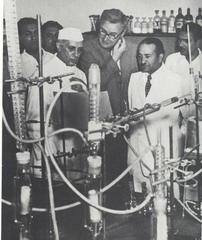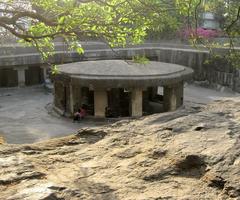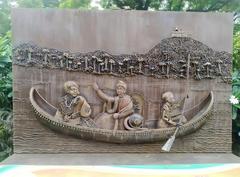Sassoon Hospital Pune: Visiting Hours, Tickets, and Historical Significance
Date: 04/07/2025
Introduction
Sassoon Hospital in Pune is a landmark that embodies a rich blend of historical legacy, architectural heritage, and modern medical excellence. Established in 1867 through the philanthropy of Sir David Sassoon, the hospital has grown from serving 144 patients to becoming one of Maharashtra’s largest healthcare centers, now boasting over 1,296 beds and serving millions. Beyond its primary role as a healthcare provider, Sassoon Hospital is a culturally significant institution, reflecting both Pune’s colonial architectural legacy and its evolving social narrative. Its history is marked by pivotal roles during public health crises, major medical milestones such as Mahatma Gandhi’s 1924 emergency surgery, and ongoing contributions to medical education and community service. This guide provides a detailed overview of Sassoon Hospital’s history, visiting information, and cultural importance for those interested in Pune’s heritage (source, source, source).
Table of Contents
- Founding and Early Development (1867–1911)
- Role in Public Health and Epidemics
- Mahatma Gandhi’s Historic Operation (1924)
- Affiliation with B.J. Government Medical College
- Architectural and Cultural Heritage
- Visiting Sassoon Hospital: Information for Visitors
- Frequently Asked Questions (FAQ)
- Notable Milestones and Contributions
- Conclusion
- Useful Links
- References and Further Reading
Founding and Early Development
Sassoon Hospital’s origins trace back to 1867, when Sir David Sassoon, a prominent Jewish philanthropist, funded its establishment to address Pune’s growing medical needs (source). The hospital began with 144 beds and a mission of providing accessible care regardless of social or economic status. Subsequent expansions were funded by Jacob Sassoon in 1909 and Shri Anklesaria in 1911, increasing capacity and improving infrastructure. These developments laid the groundwork for Sassoon Hospital’s emergence as a leading institution in Maharashtra’s healthcare landscape.
Role in Public Health and Epidemics
Throughout its history, Sassoon Hospital has been at the forefront of public health responses. During the 1892 plague epidemic in Pune, its staff played a crucial role in patient care and containment efforts. More recently, in the 2009–2010 swine flu outbreak, the hospital developed the influential “Pune Pattern” for epidemic management, pioneering dedicated ICU units that became a national model. The hospital also responded rapidly during emergencies such as the 2010 German Bakery bomb blast, providing critical care and coordination with local authorities (source).
Mahatma Gandhi’s Historic Operation
A defining moment in Sassoon Hospital’s history occurred in 1924 when Mahatma Gandhi underwent an emergency appendectomy. Due to a thunderstorm that caused a power outage, the operation was performed by hurricane lamp light, demonstrating the hospital’s resilience and its place in India’s national history (source).
Affiliation with B.J. Government Medical College
Since 1946, Sassoon Hospital has served as the primary teaching hospital for the Byramjee Jeejeebhoy Government Medical College (BJGMC). This partnership has elevated its role in medical education and research, providing clinical experience for students across numerous specializations (source). Today, the hospital supports the healthcare needs of more than 9.4 million people in Pune district.
Architectural and Cultural Heritage
The hospital’s campus reflects a blend of colonial-era and modern architecture. Landmark structures, such as the original David Sassoon building and the Jacob Sassoon wing, feature distinctive stonework and spacious courtyards (Wikimedia Commons). Restoration efforts are ongoing to preserve these heritage buildings, emphasizing traditional craftsmanship. The hospital also supports community welfare through organizations like SOFOSH, which manages child care and adoption services.
Visiting Sassoon Hospital: Information for Visitors
Is the Public Allowed to Visit?
As an active medical facility, public access is restricted to patients, staff, and authorized visitors. However, heritage enthusiasts may view the hospital’s exterior architecture and, with prior permission, visit certain areas of historical significance. Those interested in academic or heritage visits should contact the administration or B.J. Medical College for guidance (source).
Visiting Hours
- General Visiting Hours: Typically from 10:00 AM to 12:00 PM and 4:00 PM to 6:00 PM for patient visitors.
- Heritage Visits: By prior arrangement only; contact hospital administration.
Photography and Tours
- Photography: Not permitted inside hospital premises to protect patient privacy and security.
- Tours: No regular guided tours are available. Heritage walks or academic visits may be possible through arrangement with the hospital or local heritage organizations.
Accessibility and Nearby Attractions
- Location: Prakash Narayan Road, Agarkar Nagar, Pune, Maharashtra 411001, less than 1 km from Pune Junction Railway Station.
- Transport: Well-connected by public transport; parking is available but limited.
- Nearby Attractions: Shaniwar Wada, Aga Khan Palace, Pataleshwar Cave Temple, and Dagdusheth Halwai Ganpati Temple are nearby sites of historical interest.
Frequently Asked Questions (FAQ)
Q: Can the public visit Sassoon Hospital for heritage purposes?
A: Public access is primarily restricted, but heritage visits may be arranged with prior permission.
Q: What are the standard visiting hours?
A: Generally 10:00 AM – 12:00 PM and 4:00 PM – 6:00 PM for patient visitors; confirm with hospital administration.
Q: Is there an entry fee or ticket required?
A: No, entry is free, but access is limited to authorized visitors.
Q: Are guided tours available?
A: Not routinely; special heritage or academic visits may be arranged.
Q: Is photography allowed?
A: Photography inside the hospital is not permitted.
Notable Milestones and Contributions
- 1867: Foundation enabled by Sir David Sassoon.
- 1892: Key role during Pune plague epidemic.
- 1909/1911: Significant expansions by Jacob Sassoon and Shri Anklesaria.
- 1924: Emergency operation on Mahatma Gandhi.
- 1946: Affiliation with B.J. Government Medical College.
- 2009–2010: Developed the “Pune Pattern” during the swine flu epidemic.
- 2010: Provided critical care after the German Bakery bomb blast.
Conclusion
Sassoon Hospital stands as a testament to Pune’s enduring legacy of philanthropy, medical advancement, and community service. Its colonial architecture and storied past make it an essential part of the city’s cultural landscape. While access to the hospital is necessarily limited due to its active role, those interested in Pune’s heritage can appreciate its historical significance and explore related sites nearby. For the latest visitor guidelines, restoration updates, and heritage initiatives, consult official resources and consider using tourism platforms for enhanced experiences.
Useful Links
- Official Sassoon Hospital Website
- B.J. Government Medical College Official Site
- Pune Tourism Official Portal
- Pune Tourism Information
- Historical Images of Sassoon Hospital (Wikimedia Commons)
References and Further Reading
- Sassoon Hospital Pune: History, Visiting Information, and Cultural Significance, 2025, Worldwide Colleges (https://www.worldwidecolleges.com/education/b-j-govt-medical-college-pune/)
- Historical images of Sassoon Hospital, Wikimedia Commons (https://commons.wikimedia.org/wiki/Category:Historical_images_of_Sassoon_Hospital)
- Official Sassoon Hospital website, 2025 (http://www.sassoonhospitalpune.org)
- B.J. Government Medical College official site, 2025 (http://www.bjmedicalcollegepune.edu.in)
- Pune Tourism Official Portal, 2025 (https://www.maharashtratourism.gov.in)
- Visiting Sassoon Hospital: History, Significance, and Visitor Information in Pune, 2025 (https://punetourism.in)




